21.01.2024
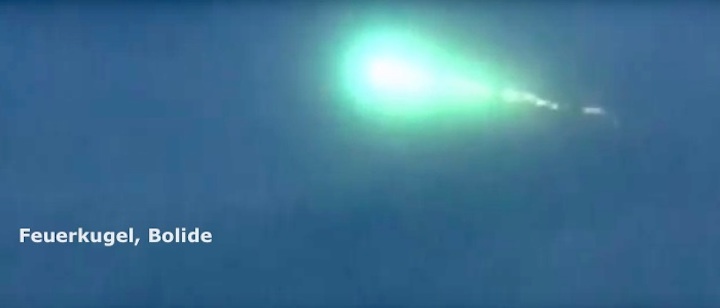

21.01.2024
Unsere UFO Meldestelle bekam in der vergangenen Nacht Beobachtungseingänge über hellen Meteor welcher sich laut NASA als kleiner Asteroid herausstellte (siehe nachfolgende Presse-Berichte von heute.
Meldungen kamen aus:
Wildau, Fürstenwalde, Grimma,
(Falleingänge: 11030, 11031, 11032,)
Stand: 10:00 MEZ
CENAP UFO Meldestelle Odenwaldkreis
+++
Blick in die Presse
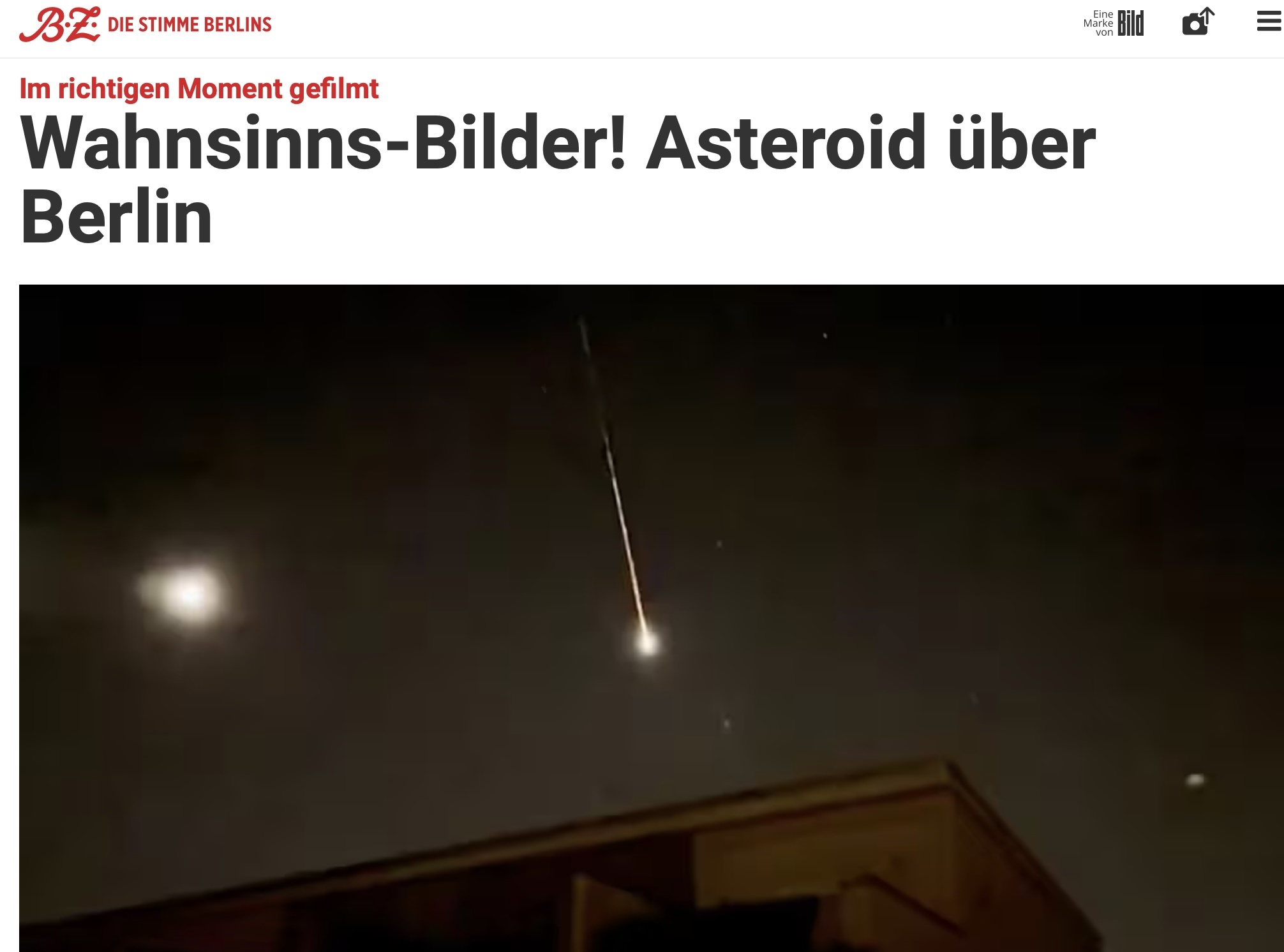
+++

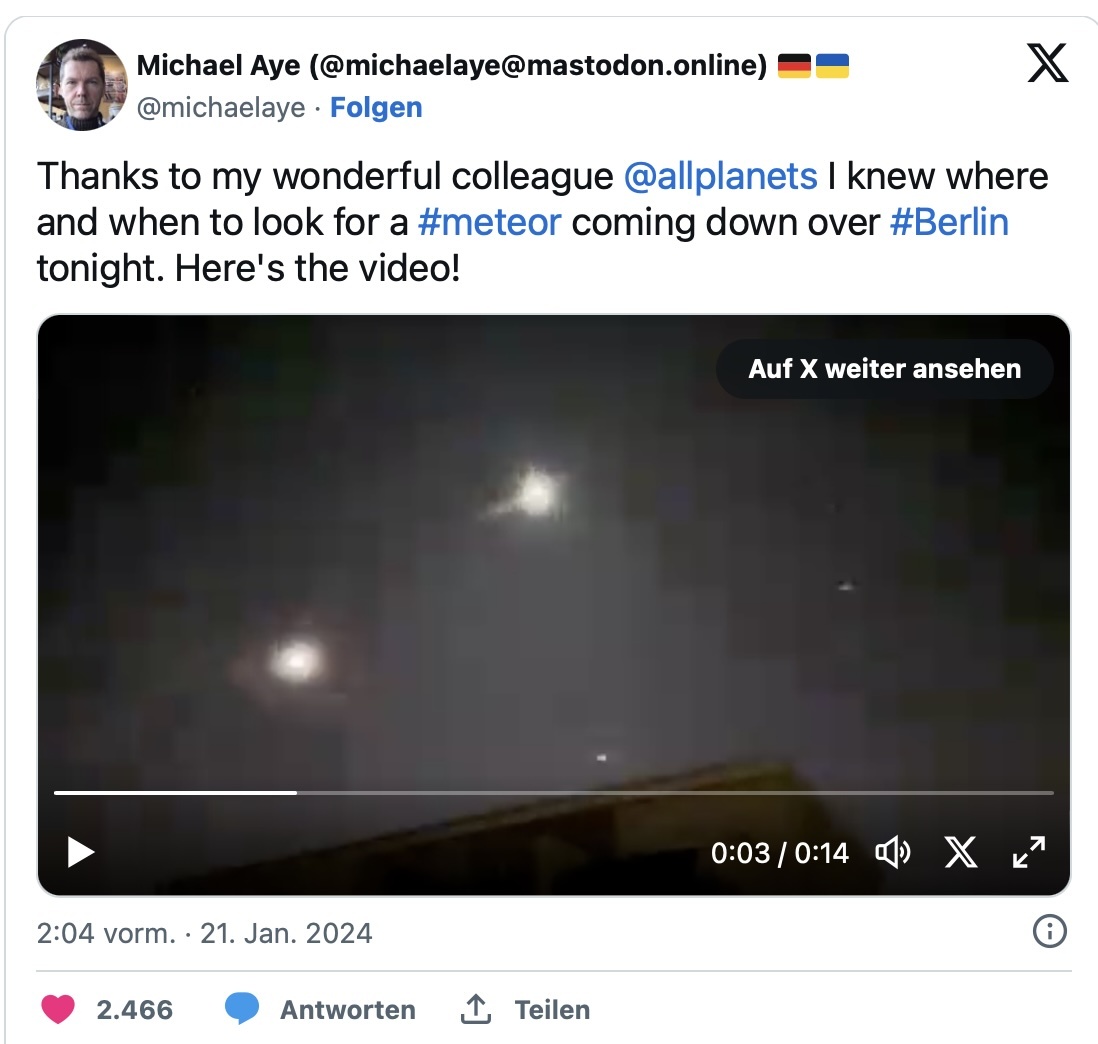
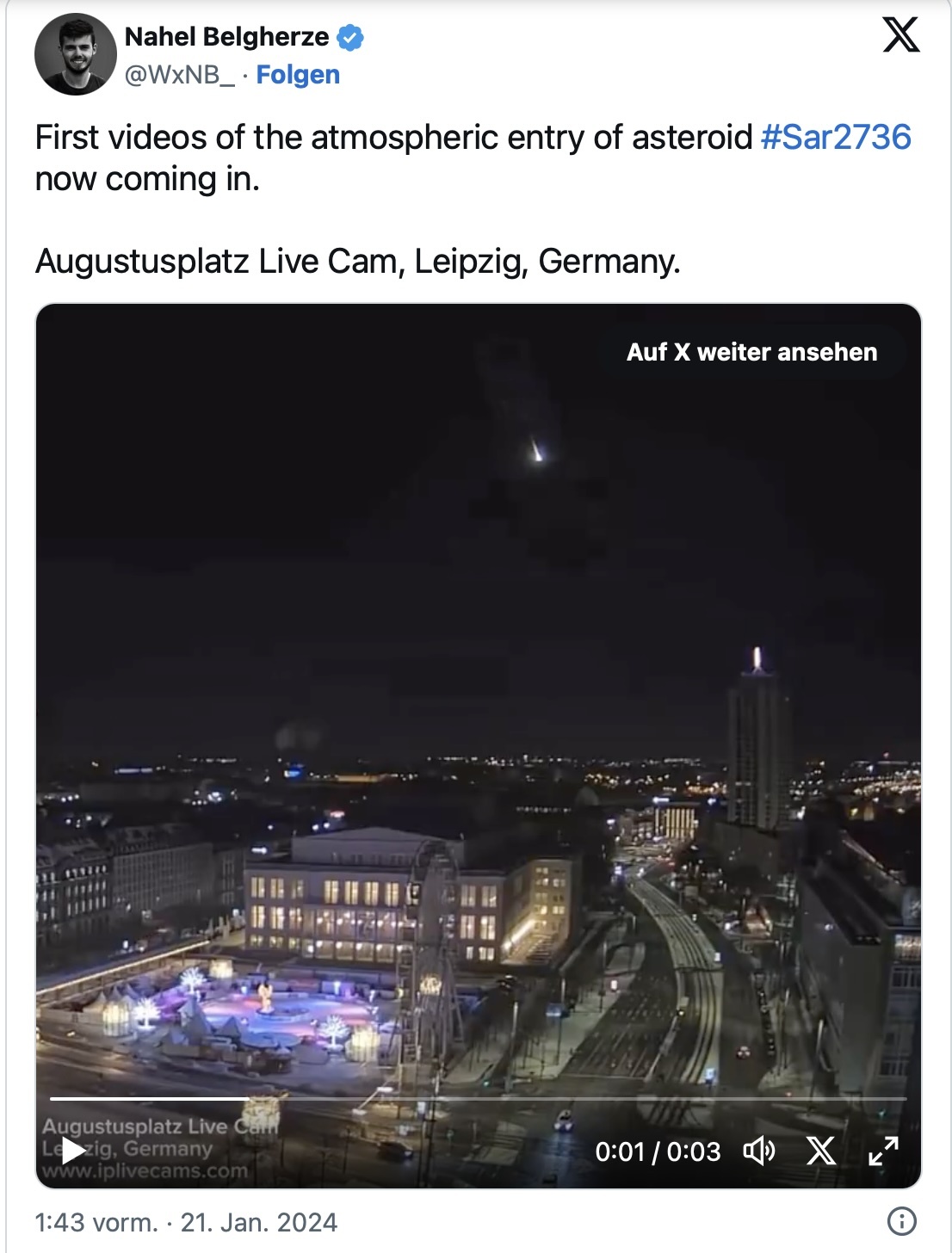
Ein heller leuchtender Fleck, dann war es schon vorbei: Ein kleiner Meteorid kollidierte mit der Erde, seine Trümmer fielen nahe Berlin herab.
Ein seltenes Himmelschauspiel war in der Nacht zum Sonntag im Osten Deutschlands zu sehen. Ein Meteorid verglühte auf dem Weg zum Erdboden. Er war in Leipzig und auch in Berlin zu sehen. Nach Berechnungen der Nasa sollte er bei Nennhausen östlich der Bundeshauptstadt einschlagen. Bislang ist aber unklar, ob es überhaupt Trümmer des Meteoriden gibt.
Der Wissenschaftler Michael Aye fing den Moment ein, in dem der Leuchtball am Himmel über Berlin auftauchte. "Dank meiner Kollegen bei Allplanets wusste ich, wann und wo ich schauen muss", schrieb er auf der Plattform X. Er konnte aber keinen Knall ausmachen, der sonst mit eintretenden Himmelskörpern einhergeht.
Die Nasa nannte den außerirdischen Felsbrocken einen "sehr kleinen Asteroiden", der auf die Erde traf. Er war offenbar erst vor Kurzem entdeckt worden, Experten vermuten, dass er weniger als einen Meter groß war.
Videoaufnahmen im Netzwerk X (ehemals Twitter) zeigen, wie ein Leuchtball kurz einen Schweif hinter sich zieht, kurz aufleuchtet und dann offenbar verglüht. Eine Webcam aus Leipzig hatte den Moment ebenfalls aufgenommen, in dem der Meteorid verglühte.
Quelle: t-online.de
+++
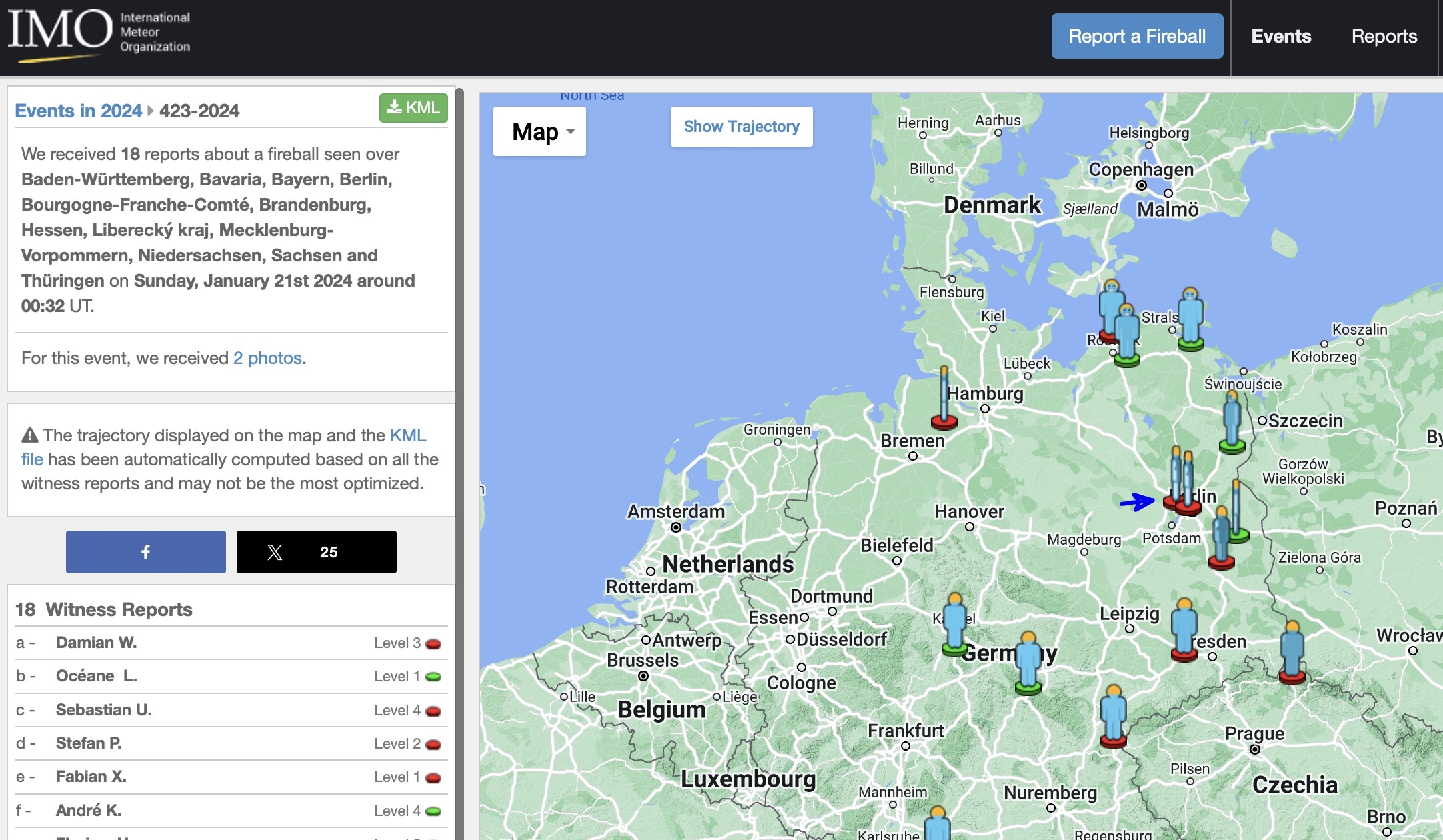
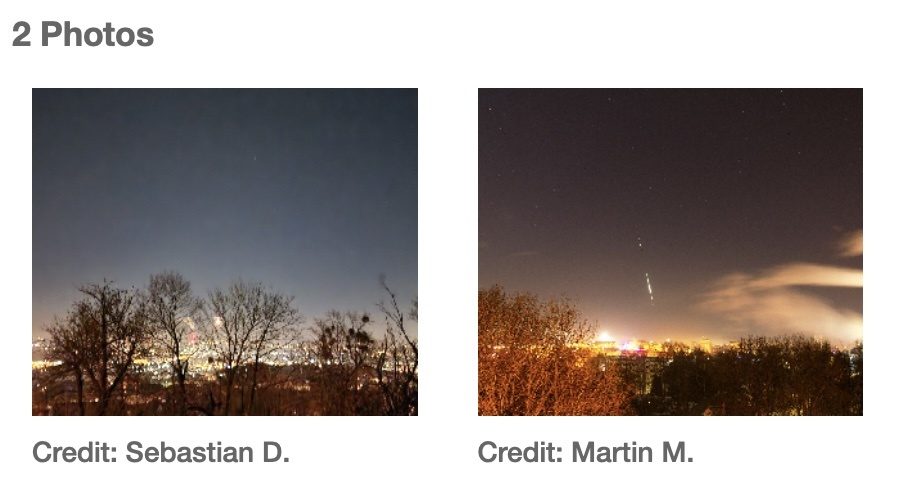
Quelle: IMO
----
Update: 23.01.2024
.
Scientists discover near-Earth asteroid hours before it exploded over Berlin
For only the eighth time in history, scientists detected an asteroid before it made its fiery appearance over Earth. The tiny fireball exploded near Berlin early on Jan. 21.
In the wee morning hours on Sunday (Jan. 21), a tiny asteroid came hurtling through the sky and smashed into Earth's atmosphere near Berlin, producing a bright but harmless fireball visible for miles around. Such sightings typically occur a few times a year — but this one was unique because it was first detected by scientists roughly three hours before impact — only the eighth time that researchers have spotted one of these space rocks before it hit.
The asteroid, dubbed 2024 BXI, was first discovered by self-proclaimed asteroid hunter Krisztián Sárneczky, an astronomer at the Piszkéstető Mountain Station, part of Konkoly Observatory in Hungary. He identified the cosmic rock using the 60-cm Schmidt telescope at the observatory. Shortly after the space rock's discovery, NASA gave a detailed prediction of where and when the meteor would strike.
"Heads Up: A tiny asteroid will disintegrate as a harmless fireball west of Berlin near Nennhausen shortly at 1:32am CET. Overseers will see it if it's clear!" NASA tweeted on the night of Jan. 20.
A live camera in the city of Leipzig in northern Germany caught footage of the exceptionally bright meteor, watching it appear and disappear in the span of a few seconds. The asteroid, which measured an estimated 3.3 feet (1 meter) wide before impact, likely started to disintegrate around 30 miles (50 kilometers) west of Berlin and "probably dropped some meteorites on the ground" along the way, Denis Vida, a postdoctoral associate in meteor physics at Western University in Canada, told CBS News.
Sárneczky has discovered hundreds of asteroids in recent years, and was the first to detect asteroid 2022 EB5 around two hours before it slammed into Earth's atmosphere. He used Konkoly Observatory data to spot that incoming rock, too.
His sighting is incredibly unusual. According to the European Space Agency, 99% of near-Earth asteroids smaller than 98 feet (30 meters) across have not yet been discovered. The smaller an asteroid is, the closer it must be to Earth before scientists can detect it, which can make it difficult to forecast impacts in advance, experts say.
In some cases, near-Earth asteroids can hide in the glare of the sun, such as the meteor that shot out from the direction of the rising sun over the city of Chelyabinsk, Russia, in 2013. That surprise space rock shattered windows, temporarily blinded pedestrians, inflicted instantaneous ultraviolet burns and injured more than 1,600 people.
Government space agencies are currently developing new technologies to scan the skies for asteroids before they make contact with Earth, including NASA's NEO Surveyor satellite, currently planned to launch in 2027, and ESA's NEOMIR, which isn't expected to launch until after 2030. Starting in 2025, the Vera C. Rubin Observatory in Chile — funded by the National Science Foundation — will catalog the solar system from the ground, and is expected to greatly help asteroid-hunting efforts.
"It took us 200 years to discover all the asteroids we know to date, about 1.2 million asteroids," Mario Jurić, the Rubin Observatory's solar system discovery team lead and the director of the University of Washington's DiRAC Institute, told Astronomy. "In the first three to six months of Rubin, we will double that."
Quelle: SC
----
Update: 25.01.2024
.
Die ersten Meteoriten des Asteroiden 2024 BX1 (der Berliner Feuerball), der am 20. Januar in unsere Atmosphäre eindrang, wurden gefunden. Die Fragmente wurden von Michał Nebelski, Kryspin Kmieciak und Kazimierz Magneto lokalisiert
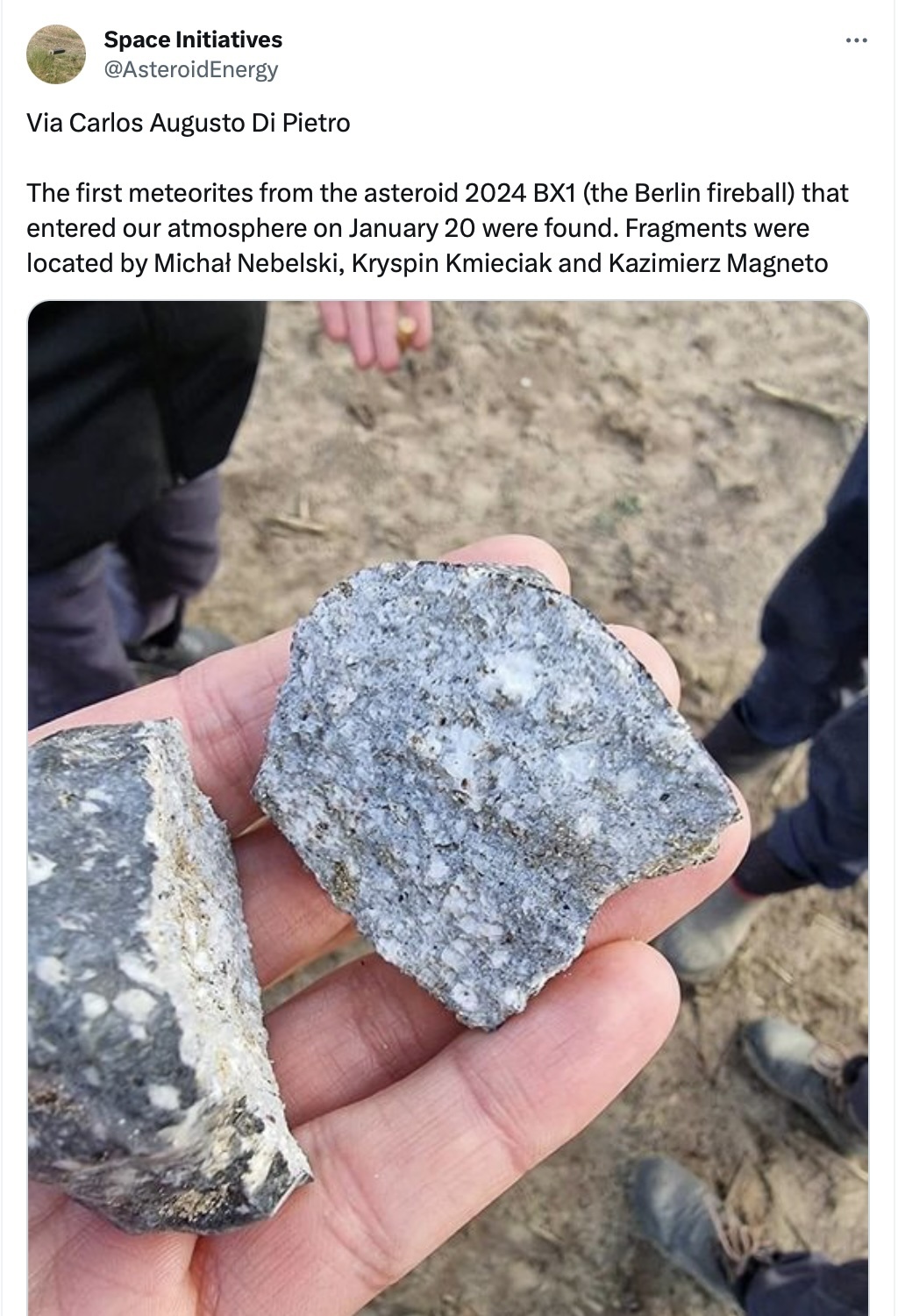
Quelle: X, Twitter
+++
NASA System Predicts Impact of a Very Small Asteroid Over Germany
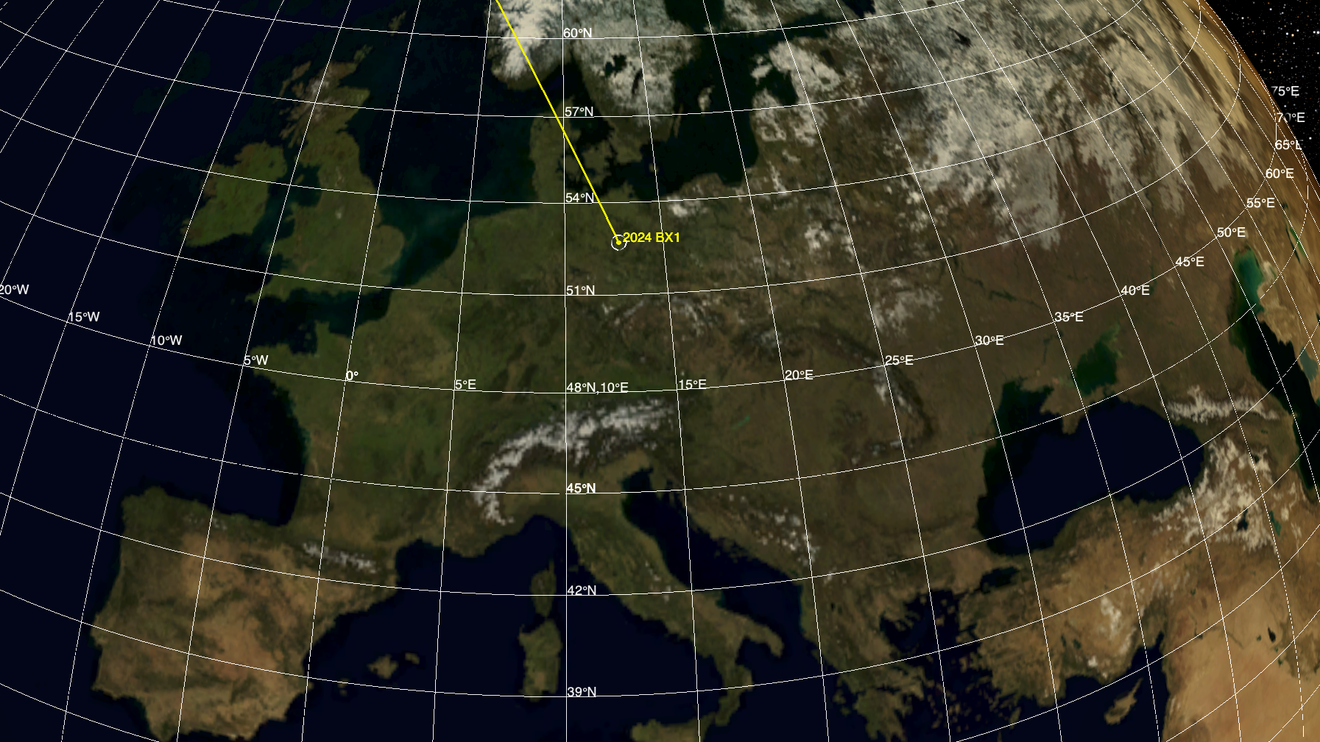
This map shows the location where the small asteroid 2024 BX1 harmlessly impacted Earth’s atmosphere over Germany, about 37 miles (60 kilometers) west of Berlin, on Jan. 21. A NASA system called Scout predicted the impact time and site within 1 second and about 330 feet (100 meters).
Credit: NASA/JPL-Caltech
The Scout impact assessment system calculated where and when the asteroid 2024 BX1 would impact Earth’s atmosphere, providing a useful demonstration of planetary defense capability.
A small asteroid about 3 feet (1 meter) in size disintegrated harmlessly over Germany on Sunday, Jan. 21, at 1:32 a.m. local time (CET). At 95 minutes before it impacted Earth’s atmosphere, NASA’s Scout impact hazard assessment system, which monitors data on potential asteroid discoveries, gave advance warning as to where and when the asteroid would impact. This is the eighth time in history that a small Earth-bound asteroid has been detected while still in space, before entering and disintegrating in our atmosphere.
The asteroid’s impact produced a bright fireball, or bolide, which was seen from as far away as the Czech Republic and may have scattered small meteorites on the ground at the impact site about 37 miles (60 kilometers) west of Berlin. The asteroid was later designated 2024 BX1.
While NASA reports on near-Earth objects (NEOs) of all sizes, the agency has been tasked by Congress with detecting and tracking NEOs 140 meters in size and larger that could cause significant damage on the ground if they should impact our planet. Those objects can be spotted much further in advance than small ones like 2024 BX1.
NASA’s interactive Eyes on Asteroids uses science data to help visualize asteroid and comet orbits around the Sun. Zoom in to travel along with your favorite spacecraft as they explore these fascinating near-Earth objects. Credit: NASA/JPL-Caltech
Tiny asteroids like this one impact our planet from time to time. They pose no hazard to life on Earth but can provide a useful demonstration of NASA’s planetary defense capabilities such as Scout’s rapid-response trajectory computation and impact alerts.
How It Was Predicted
The asteroid 2024 BX1 was first observed less than three hours before its impact by Krisztián Sárneczky at Piszkéstető Mountain Station of the Konkoly Observatory near Budapest, Hungary. These early observations were reported to the Minor Planet Center – the internationally recognized clearinghouse for the position measurements of small solar system bodies – and automatically posted on the center’s Near-Earth Object Confirmation Page so that other astronomers could make additional observations.
Scout, which was developed and is operated by the Center for Near Earth Object Studies (CNEOS) at NASA’s Jet Propulsion Laboratory in Southern California, automatically fetched the new data from that page, deducing the object’s possible trajectory and chances of impacting Earth. CNEOS calculates the orbit of every known NEO to provide assessments of potential impact hazards for the Planetary Defense Coordination Office (PDCO) at NASA Headquarters in Washington.
With three observations posted to the confirmation page over 27 minutes, Scout initially identified that an impact was possible and that additional observations were urgently needed. As astronomers across Europe reported new data to the Minor Planet Center, the asteroid’s trajectory became better known and the probability of its impacting Earth significantly increased.
Seventy minutes after 2024 BX1 was first spotted, Scout reported a 100% probability of Earth impact and began to narrow down the location and time. As tracking continued and more data became available over the next hour, Scout improved estimates of the time and location. Since the asteroid disintegrated over a relatively populated part of the world, many photos and videos of the fireball were posted online minutes after the event.
Tracking NEOs
The first asteroid to be discovered and tracked well before impacting our planet was 2008 TC3, which entered our atmosphere and broke up over Sudan in October 2008. That 13-foot-wide (4-meter-wide) asteroid scattered hundreds of small meteorites over the Nubian Desert.
In early 2023, another tiny asteroid, designated 2023 CX1, was detected seven hours before it entered Earth’s atmosphere over northwestern France. As with 2024 BX1, Scout accurately predicted the location and time of impact.
With NEO surveys becoming more sophisticated and sensitive, more of these harmless objects are being detected before entering our atmosphere, providing real exercises for NASA’s planetary defense program. The details gathered from such events are helping to inform the agency’s mitigation strategies should a large and hazardous object on a collision course with our planet be detected in the future.
Quelle: NASAAsteroid 2024 BX1 spotted three hours before impact
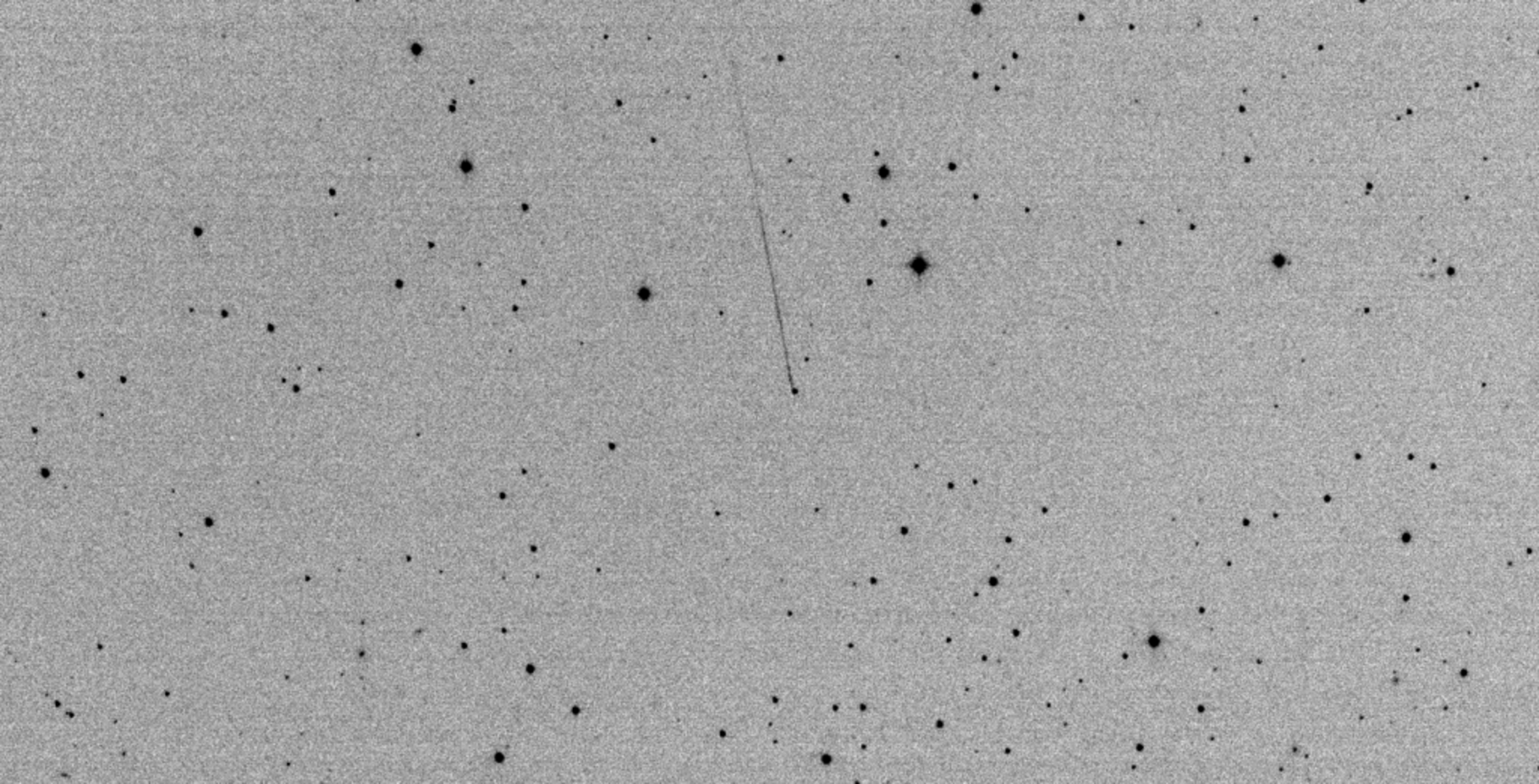
In-depth
It was at 22:48 CET on Saturday 20 January when veteran asteroid hunter Sárneczky discovered a new asteroid using the 60 cm Schmidt Telescope at Piszkéstető Mountain Station, part of Konkoly Observatory in Hungary.
He immediately sent his data on the asteroid’s trajectory to the Minor Planet Center, but with just three initial observations, it was impossible to know for sure whether it was on a collision course with Earth.
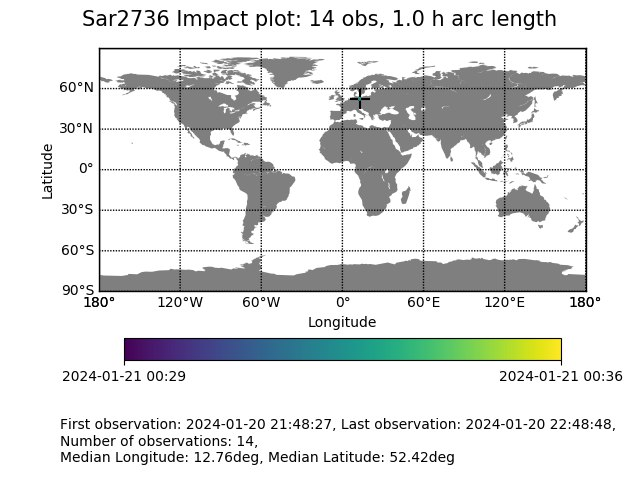
However, Sárneczky continued tracking the asteroid, and just a few minutes later, he shared four more observations that clearly indicated a 100 % chance of an imminent impact.
Automatic impact monitoring systems around the world, including ESA’s ‘Meerkat’, responded to these new data and sprang into action, issuing an alert to astronomers and asteroid experts.
Sárneczky continued to make and report his observations and was soon joined by others in Europe. More than a dozen observatories turned their eyes towards the incoming object. With their help, it soon became clear that the small asteroid, roughly one metre in size, would impact Earth in less than two hours, approximately 50 km west of Berlin, Germany.
Asteroids of this size strike Earth on average every couple of weeks. They pose no significant danger, and most are never detected. But they can help us understand how many small asteroids are out there and we can study the fireballs they produce to determine what they are made of – if we catch them on camera.
Thankfully, large asteroids that are many kilometres in diameter are much easier to spot and relatively rare. The vast majority of near-Earth asteroids that would cause devastating damage if they were to impact our planet have already been spotted, and we know of none that will collide with our planet for at least the next one hundred years.
As Saturday night became Sunday morning, astronomers continued to track asteroid 2024 BX1 until, at 01:25 CET, it entered Earth’s shadow and disappeared from view.
Observers held their breath, but they didn’t have to wait for long. Just a few minutes later, at 01:32 CET, 2024 BX1 struck Earth’s atmosphere and burned an explosive streak through the night sky. Many people in the Berlin area and across central Europe were able to witness the fireball, and a handful of people and automated camera systems even managed to record it.
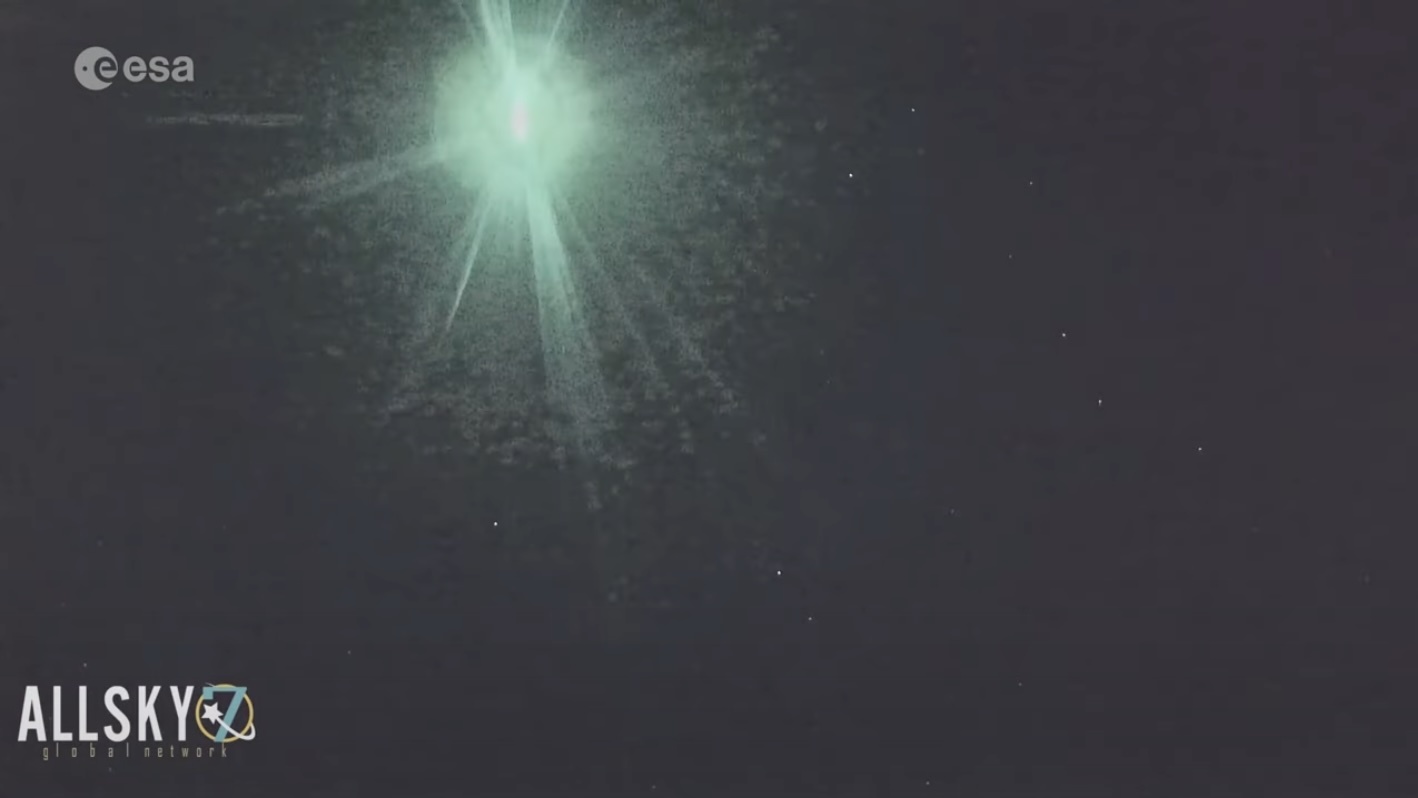
Only eight asteroids have ever been detected before impact with Earth’s atmosphere. The first of these discoveries took place in 2008, and four were detected in just the last two years. As humankind’s ability to detect smaller space objects continues to improve, this number is likely to rise exponentially in the coming years.
During the three hours between detection and impact, around 180 observations were submitted to the Minor Planet Center, including those of ESA’s Near-Earth Object Coordination Centre taken from Tenerife, Spain.
Thanks to the rapid response and information sharing from Earth’s asteroid and fireball communities, many people were able to see and record this spectacular sight, despite it taking place with just hours’ notice and in the middle of the night.
The hunt is now on for any potential meteorites that survived the fiery journey through the atmosphere and made it to the ground.
Quelle: ESA
----
Update: 28.01.2024
.
ASTEROID 2024 BX1: FROM A DOT OF LIGHT TO FIREBALL TO ROCKS ON THE GROUND
Observations from amateur and professional astronomers made it possible for NASA to predict the precise time and landing location of an asteroid discovered less than 3 hours in advance. Now hunters are turning up fragments from the fall!

David Göttlich
Like an unexpected guest crashing a party, a meter-size (3.3-foot) asteroid slammed into Earth’s atmosphere over Germany early on January 21st, producing a spectacular fireball. What made this event even more remarkable was that the asteroid, designated 2024 BX1, had been discovered less than 3 hours before impact.
Krisztián Sárneczky at Konkoly Observatory’s Piszkéstető Mountain Station in Hungary first recorded the asteroid when it was still just an 18th-magnitude blip in the constellation Lynx. Here’s the gif time-lapse of its movement:

Sárneczky reported his observations to the International Astronomical Union’s Minor Planet Center, and they were then automatically posted to the Near-Earth Object Confirmation Page(NEOCP). Other observations began to come in as word spread.
After three reports to the page over the next 27 minutes, NASA’s Scout hazard assessment impact system automatically flagged the new object as a potential impactor. Scout continually monitors NEOCP and calculates an object’s possible trajectory and chances of colliding with Earth. Similarly, the European Space Agency's Meerkat Asteroid Guard (Meerkat for short) scans NEOCP and computes preliminary orbits and impact potentials for newly discovered objects. Both programs were crucial in refining 2024 BX1's orbit.

NASA / JPL-Caltech
With an impact now a real possibility, urgent calls went out for follow-up observations. European astronomers — primarily amateurs — dropped what they were doing to aim their telescopes at the asteroid and make additional position measurements. Just 70 minutes after Sárneczky’s discovery, Scout reported a 100% probability of impact and narrowed down the fall location to 60 kilometers (37 miles) west of Berlin, estimating an impact time of 0:33 UT (January 21).
NASA then turned to X (formerly Twitter) and at 7:08 p.m. EST (0:08 UT) — just 24 minutes before predicted impact — posted on its @AsteroidWatch account:
Heads Up: A tiny asteroid will disintegrate as a harmless fireball west of Berlin near Nennhausen shortly at 1:32am CET. Overseers will see it if it’s clear!
Michael Aye
Social media lit up with the news. Incredibly, those who got wind of the alert had only to walk outside at the appointed time to witness the asteroid’s crackling, tumultuous end, exactly when and where Scout had predicted. As it spalled to pieces in the atmosphere, the fireball was visible from as far away as Slovakia, according to reports in the American Meteor Society’s Fireball log.
Observers described the meteoroid’s fragmentation, but none reported any accompanying sounds. This might have indicated that it completely disintegrated with no fragments surviving the fiery plunge. Happily, that turned out to not be true.

Filip Nikodem
On Thursday, January 25th, after three days of scouring the predicted fall site west of Berlin, four Polish meteorite hunters successfully recovered meteorite fragments. Some meteorite enthusiasts were a bit skeptical at first because the stones lacked the typical black, satiny fusion crust, which usually forms due to the brief but intense heating meteoroids undergo during atmospheric entry. But not all meteorites display such crust.

Filip Nikodem
Achondrites known as aubrites are often light-toned and display a pale brown or light gray fusion crust. They’re also quite rare. While specimens found by the crew and others have yet to be classified, aubrites remain an intriguing possibility. Other clues seem to point in that direction, too, including a sulfurous odor, brecciated texture, and those large, white crystals, which might be enstatite, a mineral commonly found in aubrites.

Filip Nikodem
The four hunters have returned to the area to look for more and have been joined by many others, among them scientific researchers. We should be seeing and hearing more very soon, including a classification.

Szigeti Tamás / CC BY-SA 4.0
The asteroid, 2024 BX1, was Sárneczky’s third pre-impact asteroid discovery and only the eighth time an asteroid has been found and successfully predicted to collide with Earth. His previous discovery, the similar-sized 2023 CX1, slammed into the atmosphere on February 13, 2023, less than 7 hours after discovery. It dropped meteorites over Normandy, France. It was later classified as an L5-6 chondrite and christened Saint-Pierre-le-Viger after a nearby town. Scout was also instrumental in predicting the time and location of that fall.
It’s heartening to see how a combination of alert observers, reporting sites, and sophisticated tools like Scout worked in tandem to alert the world to potential impactors. While this impactor was small, coordinated efforts in spotting and tracking objects could in turn lead to improved mitigation strategies for going after the big ones that could cause real harm.
Quelle: Sky&Telescope
